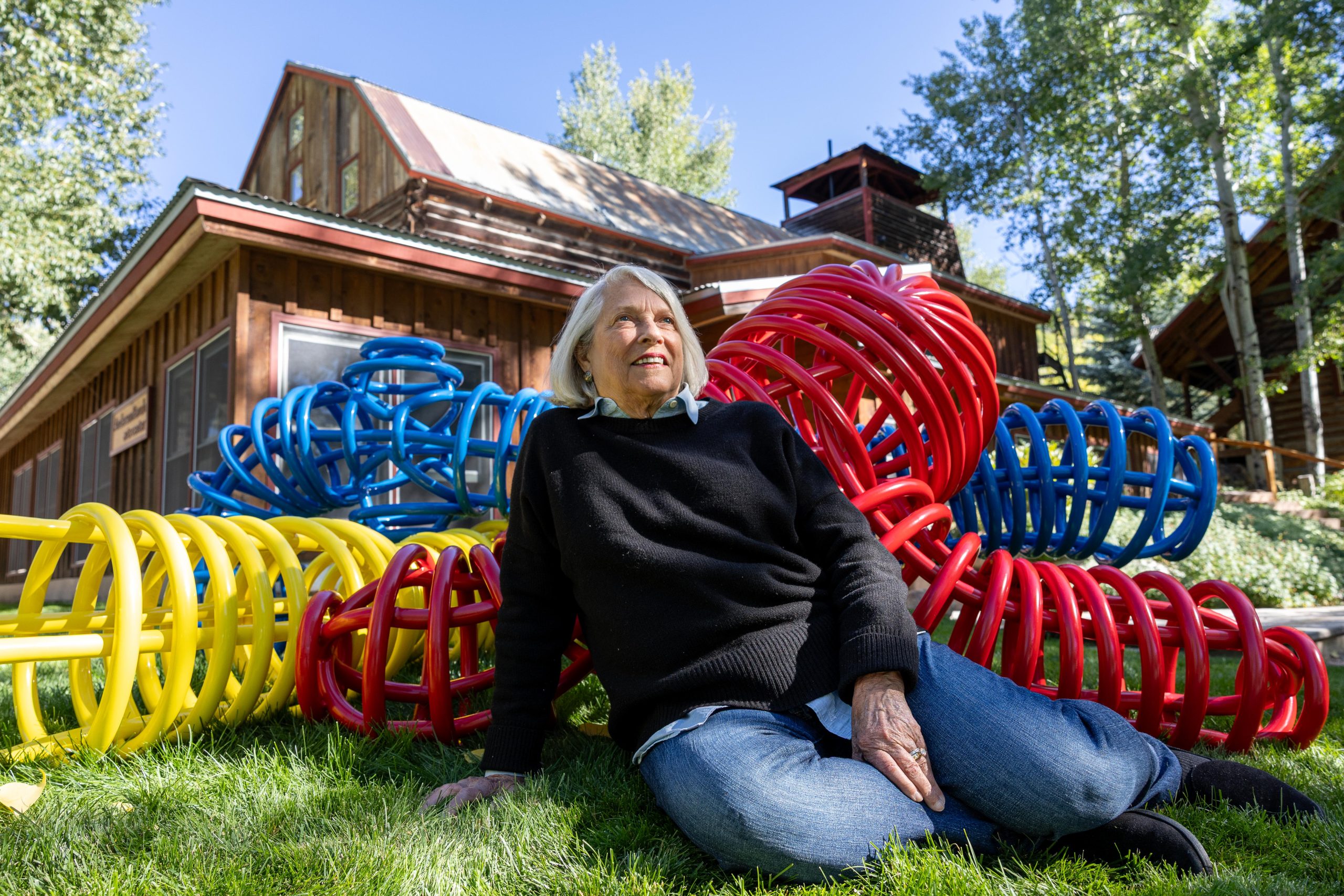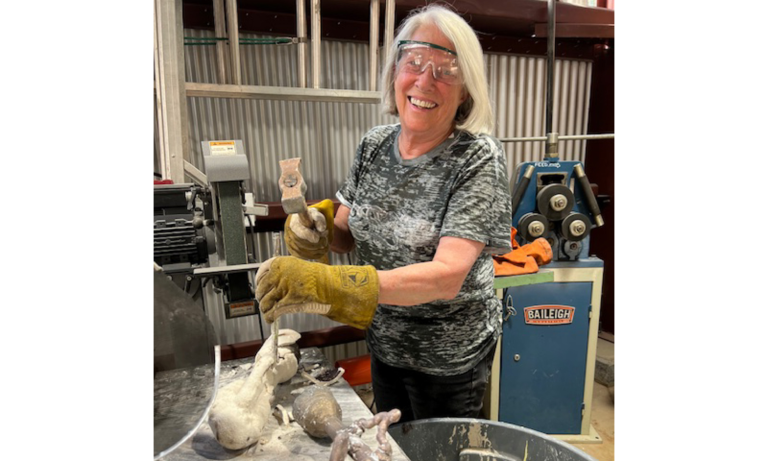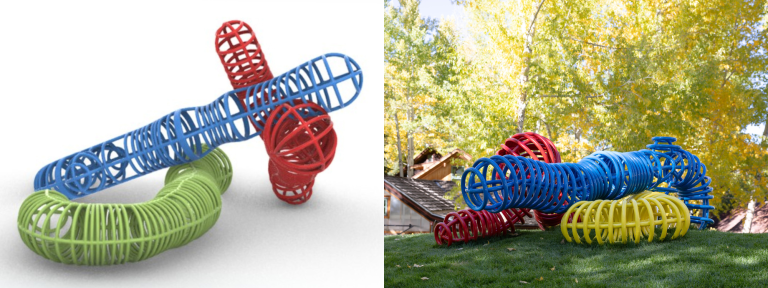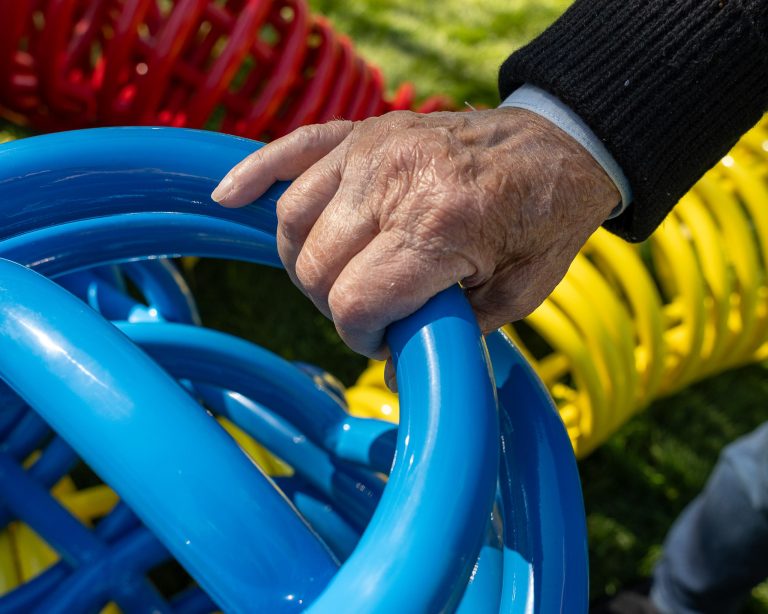Full Circle: A Conversation with Bunny Burson
November 18, 2025
Posted In: Full Circle: Creativity for All

Artist and longtime Ranch supporter Bunny Burson embodies the spirit of our “Full Circle” campaign, which honors the generous cycle of learning, making, and giving back that defines our community. As a workshop participant, former trustee, and mentor, Bunny has grown her own artistic practice at the Ranch while creating opportunities for others to do the same. Her journey from curious visitor to exhibiting artist culminates this year with her sculpture, The Common Code, now on view on the Anderson Ranch campus—a testament to the creative pathways she helped forge and that she herself has followed.
Q: How did you first come to Anderson Ranch?
Bunny: As I look back, I see it’s been almost 20 years since we came to the Roaring Fork Valley. I knew I wanted to be close to Anderson Ranch, even though I had never been there before.
The first day, I walked five minutes up the hill to the Ranch and saw what I could never have anticipated. It was just such a magical place.
I had never been to any place like it, and I’ve been to a lot of places. But I knew that there were lots of possibilities for me, for my family, and for helping others know about the Ranch.
Q: I’m so curious why you knew you wanted to be close to the Ranch before you had even been there.
Bunny: I don’t know if I can answer that. It’s funny. I had heard about it—it had a reputation. I’d heard about it from one of my faculty members at Washington University who had been there. It was just something I knew the Ranch had that I wanted, but I didn’t really know what that was until I got there and became engaged and immersed in workshops and meeting people.
It was one thing after another that helped me and my family. I had to talk Charles, my husband, into taking a workshop. He said no, and he said no again. Finally, when he took his first class, he was smitten, just as I was. Then our daughter took a class, and then our granddaughter as well. It was a family affair, and we all have benefited from having that association with the Ranch.

Q: Can you tell us about the different roles you’ve had at the Ranch?
Bunny: I was on the board for about eight years, starting around 2008, which gave me a firsthand look at what it takes to sustain access for others. I have also been involved in the university partnership program, using my experience at Washington University to help make it possible for students and faculty to come to the Ranch. I’ve also felt good about bringing new people to the Ranch from the Roaring Fork community and trying to weave together people from the music world, the art world, the Aspen Institute, and the museum.
Q: What’s the most memorable workshop you’ve taken at the Ranch and why?
Bunny: I was hoping you’d ask me that. In 2013, the January Studio Sessions gave us the opportunity to have the run of the whole Ranch. I had the most fabulous experience trying everything the Ranch had to offer. I tried ceramics, photography, every single thing. Those three weeks gave me everything that I wanted and needed.
One thing I did during those three weeks was use the CNC router to make a very large woodcut that I would never have been able to do by hand. That gave me the wherewithal to do more, and then to keep going, thanks to the Digital Fabrication Lab and studio coordinator Leah Aegerter, with laser printing, 3D printing, and so many things that opened up a whole new world for me.
My mind went to objects—I saw what I needed to do. I saw how things work and how to get comfortable with a medium I wasn’t used to.
It involved seeing what was possible and being open to whatever happened, even if it was losing a lot of what I had just made and fired.
It gave me courage and kept me from feeling like, “I don’t even want to try this again.” I had the urge to move forward and try something brand new.
Q: Your sculpture, Common Code, which you co-produced with former Digital Fabrication Coordinator Leah Aegerter, is now part of the Ranch’s outdoor sculpture exhibition. Can you tell us about what sparked the original idea and how it came to fruition?
Bunny: It was such a long journey. I was working with my family history using traditional materials, and almost the next day after I finished that body of work, I opened up The New York Times and saw they had sequenced the DNA of a Zika mosquito. I was so taken with that image and with another possibility that I decided to have my own DNA sequenced. That led me to want to make those images three-dimensional.
Then the pandemic hit. Leah had time, I had time, and we had the opportunity to work together, which I had looked forward to since I had gotten to know her. We worked on creating relief images for a commission, and that grew until I expanded the journey to enlarge those small chromosomes. I found a foundry that helped me, along with Leah. It was my first experience having people help me make something.
Q: And how did Leah help you make the sculpture?
Bunny: She taught me a new program called Rhinoceros, so I was able to manipulate the images from my DNA on the screen—move them around, make them larger, and form a sculpture. It was a big journey from the screen to the Urban Arts Project foundry to what is now installed at Anderson Ranch.
It took a village, and that village was born from that initial connection at the Ranch. The idea was birthed there, fostered there, and now it’s literally there.
I am so proud of this intergenerational collaboration, and of making it come full circle.

One thing I want to say is I could not have imagined any of this happening when I walked onto the campus 20 years ago. I had no idea what was possible. But it’s the place that I think shaped me as an artist more than any other experience. I wouldn’t have been able to say I was an artist.
I feel like I became an artist, thanks to the Ranch.
Q: What do you hope to see for the Ranch’s future and for the artists who come here?
Bunny: I want to see future partnerships within the valley and outside of it. I want to see more people come to speak at the Ranch—whether they’re household names or not—who can really light that spark we all feel when we get here. I love that so much is online now, that you can take a class or go to a lecture online. We just need to use the technology available to us to reach more people and make it more accessible, and then hopefully be able to bring more people onto campus where a lot of that magic continues.
Q: What responsibility do donors share in ensuring the Ranch’s longevity and access?
Bunny: You can’t give to a nonprofit and then all of a sudden stop, because they’re counting on you. When a donor starts, they need to keep on going. I think that participants who come to the Ranch and are excited about what they have gotten—the connections they’ve made, the friendships that have started—should make it possible to support the Ranch in whatever way they can. It’s not enough to just come and take a workshop and pay the tuition or receive a scholarship. Giving back “full circle” to the Ranch is saying that it’s more than that.
It’s really important that everyone who has had the Ranch experience contributes so that others can enjoy that same opportunity.
I can’t even imagine what life would be like without the Ranch at its full capacity. Those of us who’ve had this incredible opportunity have a responsibility to go full circle and make sure that others have that same opportunity.

When supporters step in, the circle continues—keeping access, mentorship, and art-making alive for the next generation.
Join the Circle | Donate Today



